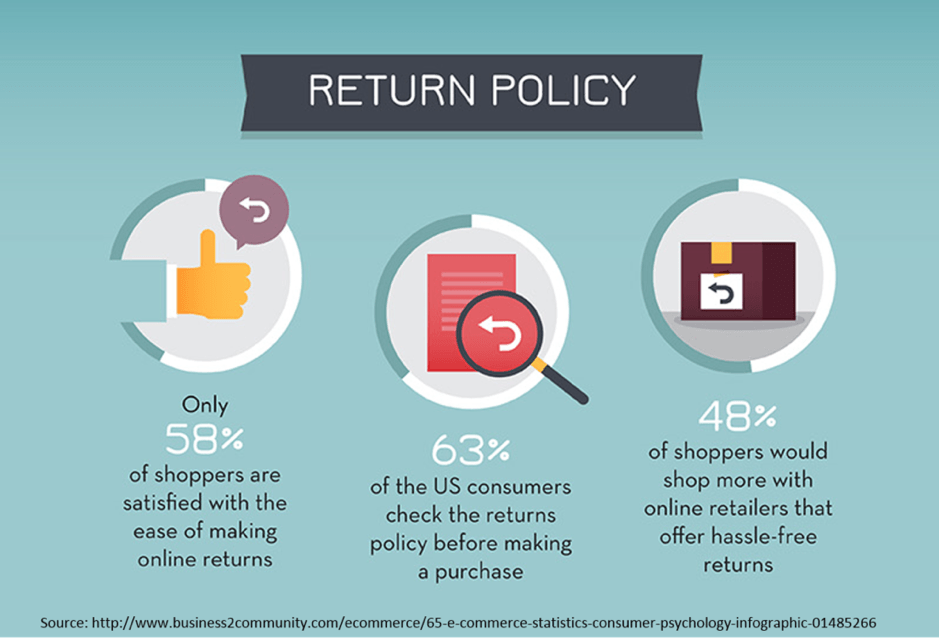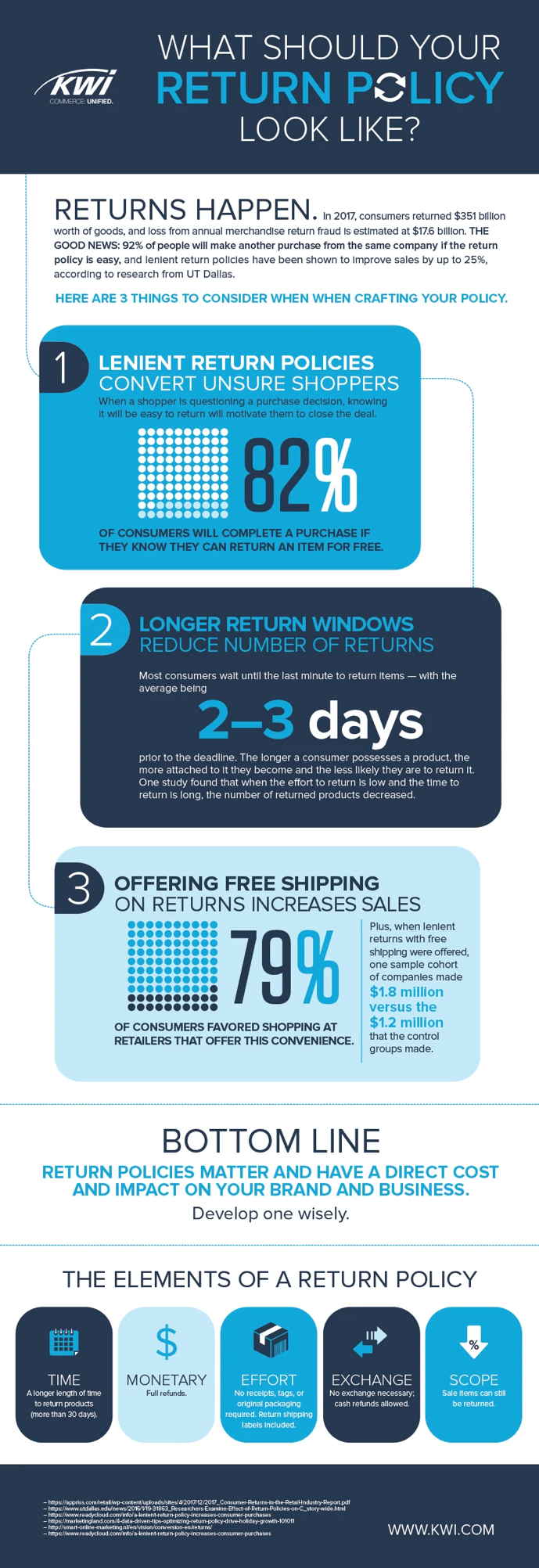Understanding Etsy’s Return Policies

As an Etsy seller, you pour your heart and soul into your shop – capturing detailed product photos from all the right angles, spending hours writing compelling descriptions, and picturing happy customers sporting your unique goodies.
But what happens when that daydream turns into a return request? Not only do you have to return the money from the sale and figure out what went wrong, you also have to figure out the whole return policy. Etsy returns can feel a little unclear for new sellers.
That’s why we’ve put together this guide to equip you with the knowledge to navigate Etsy’s return policy confidently!
Why should my Etsy shop include a return policy?
Did you know that 63% of US shoppers check the return policy before making a purchase? This means that not having one could potentially see you losing out on over 60% of your potential sales.
Here are some other reasons why they’re a must as an Etsy seller:
- Protects you from unfair and/or unnecessary return requests.
- Fosters trust and transparency between you and your buyers – they know they can return an unsuitable item.
- Minimizes unhappy buyers leaving negative reviews.
- Reduces purchase hesitation.
- Demonstrates a commitment to customer satisfaction.
- Helps you gather customer feedback to improve your product descriptions, sizing charts or even product quality.
- Gives you a competitive advantage by setting you apart from shops that don’t offer returns or have unclear policies.

Unpacking the Etsy return policy
Unlike big-box stores and other online marketplaces with uniform return policies, Etsy allows sellers to set their own terms. This freedom lets you tailor your return policy to your specific products and business needs.
However, it also means you’re responsible for writing up your own shop policies, which can be confusing for both you and your customers if they’re not done right. And let’s face it – you’re a creative entrepreneur, not a lawyer!
If you live in the EU or sell to customers in the EU, your products will be subject to the EU Directive on Consumer Rights which states that buyers can return items within 14 days of purchase. As a seller, you need to make this clear on your profile. If you don’t, the buyer will have an additional year to return the products. This policy, thankfully, doesn’t include custom-made goods or perishable items.
Return policy placement
Etsy sellers have a fair amount of freedom with the placement of their return policies, but nonetheless, you should make them as easy as possible for your buyers to find.
Trying to bury them in your descriptions or shop policies can appear shady. Here is where you can add your individual return policy:
- Directly in the Listing: You can include a clear and concise return policy directly within the product description. Add a heading titled “Returns & Exchanges” or something similar to make it easy for buyers to find.
- Shop Policies Section: You can also opt for a dedicated “Shop Policies” section on your Etsy storefront. This is where you can outline your general return policy alongside other important details like processing times and shipping costs.
- Confirmation Email: When a buyer makes a purchase, Etsy sends them a confirmation email, where you can customize the message or add attachments. It’s a good idea to add your return policy here too, so you know the buyer has had every opportunity to read your T’s and C’s.
What to include in your shop policy
Now that you understand why you need one and where to place them, it’s time to create one! But now, the question of what to include in your return policy may be stressful. Here are some important elements to consider:
- Return window: This dictates how long a buyer has after receiving the item to initiate a return. Common return windows range from 14 days (often the minimum for EU sellers due to regulations) to 30 days, though you may choose to offer a more generous window.
- Return eligibility: You may choose to exclude certain categories from returns, like custom-made items, digital products, or perishable goods. If you sell different types of goods with each one having a different return policy, make that clear upfront.
- Return shipping costs: Who shoulders the cost of shipping the item back to you? Many sellers opt to carry the cost of the return if it is due to damaged, faulty, or incorrect goods received. If the buyer is returning the item because they don’t like it or bought the wrong size, then you can add it to your terms and conditions so that they foot the bill.
- Condition of return: You should always insist that the item be returned in its original condition, with any tags or packaging intact. Any damage beyond normal wear and tear could disqualify a buyer from a full refund.
- Refunds vs. exchanges: The policy should specify if you offer refunds, exchanges, or both. If you prefer, you can offer the option to choose between a refund or an exchange for store credit.
Here are some additional statistics to consider when writing your store policies:

Remember EU buyer protections
EU residents have an extra layer of protection under EU law. The EU Directive on Consumer Rights guarantees a 14-day right of withdrawal, meaning you can generally return most items purchased online within 14 days of receiving them, regardless of the seller’s policy (though some exceptions may apply).
What happens if you can’t help the buyer with a return?
The buyer can open a case with Etsy by choosing the order and clicking on the ‘Open a case’ button. But, this option will become available to them only if they have contacted you, the seller, for help at least 48 hours before.
In case the item was damaged, never arrived, arrived only after the estimated delivery window, or isn’t as described, Etsy will offer the buyers a full refund. So, if you want to avoid having a case opened against you, be sure to respond to any return requests quickly.
How to avoid returns in the first place
A well-crafted return policy can go a long way in keeping your shop running smoothly, but you should still be prepared for a few bumps along the way. There are a few other things you can do to build trust and minimize returns:
- Proactive communication: Use Etsy’s messaging tools to follow up with customers after a purchase, answer questions promptly, and address any concerns early on.
- Clear product descriptions: High-quality photos and detailed descriptions can help set expectations and avoid misunderstandings that might lead to returns.
- Quality over quantity: Focus on creating high-quality products that meet customer expectations. This not only reduces the likelihood of returns but also builds brand loyalty.
Keep the lines of communication open
You need to foster a culture of open communication that gives buyers confidence to purchase from your shop. This should begin with any question the buyer has about the product, right down to feedback.
Of course, it’s disappointing when a customer wants to return an item, but you should still respond promptly and professionally to their concerns.
Here are some pointers for communicating with confidence:
- Be clear and concise: Restate your return policy as outlined and explain the next steps in the return process.
- Maintain a professional tone: Even if the situation feels frustrating, remember, a happy customer is a returning customer. You also want to try to calm the situation and avoid them leaving bad reviews.
- Gather information: Ask clarifying questions to understand the reason for the return. This can help you identify potential product descriptions or shipping practice improvements.
For those needing assistance in crafting these messages, seeking professional essay help can ensure your communications are concise, professional, and effective, helping to maintain a positive relationship with your customers.
In addition to that, many Etsy sellers are also turning to professional online store development services to ensure their shops stand out and provide the best customer experience.
Wrapping up
While offering returns is standard practice for most online retailers, it’s not mandatory as an Etsy seller.
However, it’s essential to weigh the potential benefits against the drawbacks. A return policy, even a limited one, can build customer confidence and encourage them to purchase from your shop.
Questions or just say hello!
Well, congratulations to you for making it this far! Here’s a reward in the form of a 10% discount code on your first month of Crosslist (add during check-out). Sign up now with a 3-day money-back guarantee!
10% off
BLOG10
You can learn more about how Crosslist works here.
If you have further questions, feedback, bug reports, or want to know a bit more about us, why not swing by for a chat and say G’day! You can have a chat with us through Messenger.
